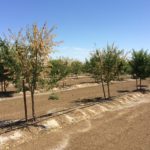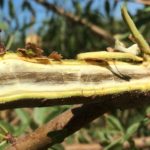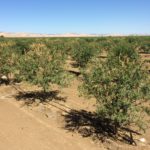The high heats of late spring/early summer can bring upon the onset of wilts. Verticillium wilt, a common occurring wilt, is caused by the fungus Verticillium dahliae Klebs. V. dahliae is widespread in soils throughout the county, with susceptible hosts in a large number of perennial and annual crops. Within perennial crops, almond and pistachio are susceptible hosts.

Leaves turn light tan and die, and often remain on the tree. In some cases, particularly in pistachio, symptoms develop slowly over several years causing a thinning of the leaves and a corresponding loss in yield as the fungus progresses up the branch. Internally, the xylem wood turns dark, and a cross section will show a ring of discolored tissue. This darkened tissue will extend down the affected scaffold to the point of origin within the root system. Several scaffolds of the tree may be involved if the pathogen infected a large portion of roots.
The fungus survives in the soil within survival structures known as microsclerotia. It enters the trees through the roots, infecting the xylem tissues of the plant. Upon infection, the fungus produces a dark pigmented substance that clogs the xylem tissues, preventing the upward flow of water to the scaffold branches. When the affected branches or leaves demand more water than it can receive due to the blockage, it collapses. Cool springs and wet soils favor disease development. The fungus is eliminated from the above-ground portions of the trees during the hot weather. The fungus may survive within the root and reinvade the upper part of the tree, but it is thought that repeated occurrences of wilt are caused by new infections each year.

Within almond, young trees within their 2nd and 3rd leaf are the most susceptible to tree loss. All almond rootstocks and varieties are susceptible, but recent rootstock trial data suggests that Lovell may be more susceptible than other rootstocks. In sites of high disease pressure, almond trees may completely collapse and need to be replaced. Losses in almond, however, are generally low as trees tend to recover and replacement is not needed. Although strikes may be visible, rushing out to remove affected branches is not advised. These branches will have no further impact on the tree and can be removed during annual pruning.
Historically, verticillium wilt is the most destructive disease of pistachio. Trees of any age can become infected and die. Resistant rootstocks have been developed and are the best defense against verticillium wilt. Severely affected trees should be removed and replaced with resistant rootstocks.

Criteria for site selection for pistachio or almond should include crop history and an assessment of the inoculums level in the soil. Locations with a crop history of tomato, pepper, melon, or cotton tend to have higher populations of V. dahliae as these crops are susceptible hosts to the fungus. If populations of V. dahliae are found, a cover crop of a non-host plant, such as corn, barley, or wheat, should be grown for two years. Pre-plant fumigation may reduce microsclerotial populations within the soil, but will not eradicate the fungus. Interplanting agronomic crops that are susceptible to V. dahliae should be avoided. Reduction of tree stresses and maintaining of tree health may reduce the occurrence of verticillium wilt. By applying proper irrigation and nutrients, the impact of verticillium wilt may be reduced.


mike barrett
June 24, 2019I always enjoy your comments, I value your experience !
Thanks
David Doll
June 25, 2019Thanks for the kind words, Mike.
Wish you the best.
David